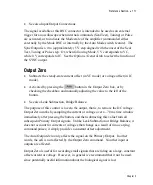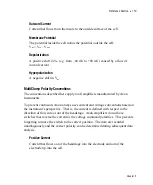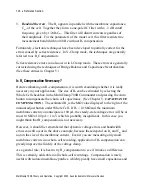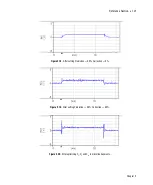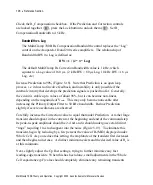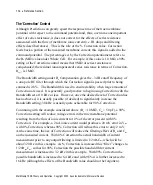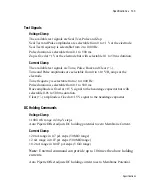
128
•
Reference Section
Check the R
s
Compensation checkbox. If the Prediction and Correction controls
are locked together (
), press the Lock button to unlock them (
). Set R
s
Compensation Bandwidth to 15 kHz.
Bandwidth vs. Lag
The MultiClamp 700B Rs Compensation Bandwidth control replaces the “Lag”
control on the Axopatch-1D and 200 series amplifiers. The relationship of
Bandwidth (BW) to Lag is defined as:
BW = 1 / (2 *
π
* Lag)
The default MultiClamp Rs Correction Bandwidth value is 1 kHz, which
equates to a Lag value of 160
µ
s. (2 kHz BW = 80
µ
s Lag, 10 kHz BW = 16
µ
s
Lag, etc.)
Increase Prediction to 90% (Figure 5.18). Note that Prediction is an open loop
process,
i.e.
it does not involve feedback, and instability is only possible if the
internal circuitry that develops the prediction signals is pushed too far. Generally,
the circuit is stable up to values of about 98%, but it can become non-linear,
depending on the magnitude of V
cmd
. This may only become noticeable after
increasing the Primary Output Filter to 50 kHz bandwidth. Reduce Prediction
slightly if severe oscillations are observed.
Carefully increase the Correction value to equal that under Prediction. A rather large
transient should appear in the current at the beginning and end of the command step.
Its peak-to-peak amplitude should be 2-4 nA and it should undergo several distinct
“rings” requiring 1 ms to disappear into the noise (Figure 5.19). To eliminate this
transient, begin by reducing by a few percent the value of R
s
(M
Ω
) displayed under
Whole Cell. As you reduce this setting, the amplitude of the transient first decreases
and then begins to increase. A distinct minimum exists and the desired value of R
s
is
at this minimum.
Next, slightly adjust the Cp Fast settings, trying to further minimize any fast
leading-edge transients. When this has been done, small adjustments in the Whole
Cell capacitance (pF) value should completely eliminate any remaining transients
MultiClamp 700B Theory and Operation, Copyright 2005 Axon Instruments / Molecular Devices




